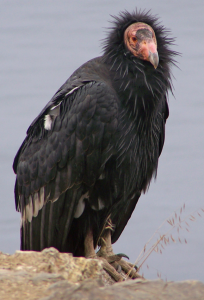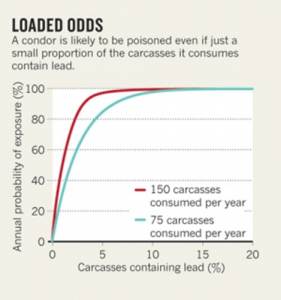California Condors and Gun Rights
by Jesse Barnes
California Condors and Gun Rights
If you frequent popular science media, you are most likely familiar with the recent struggles of the California condor, the largest bird species in the United States with an even larger population problem.
Condors are scavengers, meaning they eat animals that are already dead. Usually, such animals are killed by human hunting, so the some of the bodies that condors feed on have bullets left in them. Normally, a bullet would just pass right through the bird’s system without issue, but bullets made of lead are toxic to condors in the same way lead-based paint is toxic to humans. Lead poisoning from consuming bullets has already caused the population of wild condors to fall to as low as 22 individuals in 1982.
Since the near-extinction of the condors in 1982, captive breeding programs and medical intervention have temporarily saved the troubled bird and brought numbers up to around 400 individuals, half in the wild and the other half in captivity. However, via close population tracking, only 24 chicks are known to have been born in the wild since 1982. This is a sign that we have not fixed the root environmental problems causing these birds to die out. What good is population rehabilitation if the condors cannot eventually survive on their own?
In a study by Myra Finkelstein, a toxicologist at the University of California at Santa Cruz, a research team discovered that the amount of lead poisoning among condors has not changed, despite the efforts of conservationists and California lawmakers.
The California State Assembly banned lead bullets, which are more attractive to hunters because they are cheaper and easier to find. Copper bullets are the suggested alternative, and some hunters comply, but unfortunately most do not because of California’s inability to enforce the new laws. The state only has 300 game wardens, which is not enough, considering California’s exceptionally high population, the popularity of hunting as a pastime in that state, and the persistence of lead bullet use despite the new laws.
Typically, when laws at the state level are not working, it is natural to progress to the federal level. Naturally, the EPA (Environmental Protection Agency) handles matters concerning the environment. However, the EPA is designed to make scientific recommendations to lawmakers, the organization itself does not have independent lawmaking power. This makes the passing of legislation for the good of the environment slightly more difficult, especially when groups like the NRA (National Rifle Association) smell a left-leaning law about gun rights.
In an interview with Susan Recce, the NRA’s director of conservation, wildlife, and natural resources, about the possibility of a federal law against bullets made of lead, Recce claimed “We’d look at it as an anti-gun move.” This all boils down to the fact that the NRA is lobbying for legislation that can prevent the EPA from telling them how they can use their guns. The EPA is recommending to legislators that congress ban lead bullets for the good of the condor (based on scientific fact and peer-reviewed research), all the while NRA lobbyists claim that banning lead bullets, even though there are plenty of alternatives like copper, would violate the Right to Bear Arms. This article by Blaine Smith, Associate Editor for NRA Publications, makes it clear what the NRA thinks about banning lead bullets. They claim that the banning of lead bullets is not an attempt to save endangered wildlife, but rather a clever tactic by liberal extremists and animal-rights activists to ban hunting altogether. The unfortunate truth of the matter is that the NRA is more concerned about gaining political ground than saving the condors.
Unless lead bullets are banned, the condor will continue to be poisoned in the wild and be unable to live free from human assistance. Essentially, because of the NRA’s interpretation of the Second Amendment’s Right to Bear Arms, the California condor is losing its right to life.
Citation – Finkelstein, M. E., Doak, D. F., George, D., Burnett, J., Brandt, J., Church, M., et al. (2012). Lead poisoning and the deceptive recovery of the critically endangered California condor. Proceedings of the National Academy of Sciences, 109(28), 11449-11454. doi: 10.1073/pnas.1203141109
Further Reading –
Plight of the Condor
Guns and the Environment

